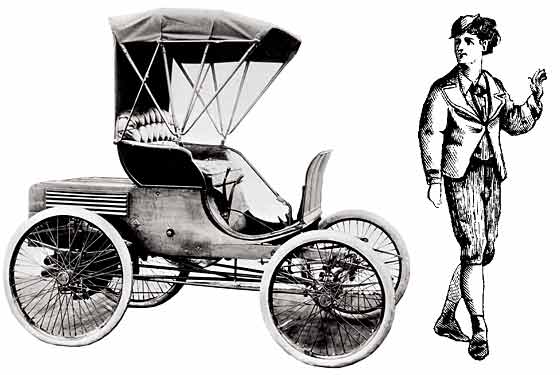
It’s traffic week! And not because of holiday shoppers. In the eye of the storm between election cycles, city politicians have exactly one year to tackle one of the most pressing yet sensitive issues there is: congestion. “The gridlock on our streets has become a brake on the city’s economy,” asserts Kathryn Wylde, president of the Partnership for New York City, an association of top city business leaders. This week, hers and a handful of other groups will roll out reports and hold conferences on the topic. Opponents have been prepping for an all-out spin war. A few weeks ago, Walter McCaffrey, a city councilman turned lobbyist, says he was hired by a nascent group calling itself the Committee to Keep New York City Congestion-Tax Free. Wylde says it’s really just “a front” for the Metropolitan Garage Owners Association. (McCaffrey says the New York State Restaurant Association is with him.) Wylde’s report will propose “anything from improved mass transit to road charges.”
1899
First pedestrian run over by a car in New York City.
1911
Mayor William Jay Gaynor removes the five-cent toll on East River bridges.
1930s
The Robert Moses highway-and-bridge building binge kicks in, filling the city with cars and creating the suburbs.
1951
Columbia University economist William Vickrey comes up with the idea of peak pricing to manage car traffic and subways. Nobody’s interested.
1962
Copenhagen, Denmark, begins closing off streets to cars downtown. “There was never any master plan,” says architect Jan Gehl. “Shopkeepers found out they were doing better. Then the next street was closed. And then every year after that, the city put in a nice square or removed some parking spaces.” Today, nearly two fifths of commuters bike.
1970
First Earth Day in U.S.
1973
Mayor John Lindsay and Governor Nelson Rockefeller approve a plan to bring the city into compliance with the Clean Air Act by putting 50-cent tolls on the East and Harlem River Bridges. It never comes to pass.
1975Vickrey’s pricing concept is implemented for the first time in Singapore, resulting in a 22 percent increase in traffic speed. (In a benign dictatorship, political opposition does not exist.)
1980
Following a transit strike, Mayor Ed Koch and the City Council agree to ban single-passenger cars from the free bridges. Parking-garage owners and the Automobile Club sue, and stop the ban.
1987
Koch’s second try is killed by a coalition of borough presidents, hotels, theaters, and hospitals. “We got Lew Rudin, president of the Real Estate Board of New York, and Teamsters president Barry Feinstein,” says lobbyist Ethan Geto. “We had a meeting—just three guys in the room. Koch withdrew it.”
1990
Janette Sadik-Khan, Mayor Dinkins’s transportation adviser, recalls “walking into Assembly Speaker Mel Miller’s office. I said, ‘Hi, I’m here to talk to you about the proposal to toll the East River bridges.’ He gave me this big smile and said, ‘Oh, that’s so cute!’ ”
1996
Vickrey wins the Nobel Prize in Economics.
1998
The mayor of Bogotá, Colombia, boosts gas taxes and uses half the revenues to create an express bus and build bike greenways. Car-free days are started, and traffic restrictions reduce rush hour by 40 percent.
2000
Ex-Socialist “Red” Ken Livingstone is elected mayor of London and hires ex-MTA chairman Robert Kiley to create a congestion charging system.
2001
Michael Bloomberg’s campaign issues a policy paper called “Untangling New York.” (First sentence: “Traffic is a mess!”) Bloomberg promises an express-bus system on First and Second Avenues and to take away parking privileges from government employees. After 9/11, Giuliani closes the East River bridges to single-passenger cars during rush hours.
2002
The mayor of Paris, Bertrand Delanoë, begins taking away road space from cars and turns an expressway along the Seine into a summertime beach. With 10 percent fewer cars entering the city, buses move twice as fast.
2003
Livingstone defies predictions of “Carmageddon!” and starts the congestion charging system: five quid to drive into the center city. Sixty thousand vehicles disappear from the streets; the amount of time people spend stuck in traffic drops 26 percent. In New York, Queens City Council members pressure Bloomberg to allow single-passenger vehicles back onto the East River bridges. He relents.
2004
Mark Gorton, a hedge-funder and the founder of LimeWire, begins pouring more than $1 million per year into a “Livable Streets” movement.
2005
The Partnership studies congestion charging. “Many of our members go to London quite a bit,” Wylde says. “They’re asking, ‘Can we do that here?’ ” The morning after Bloomberg’s reelection, she is quoted on the front page of the Times suggesting that the mayor will focus on it in his second term. Three days later, he says, “It’s not on our agenda to look at it.”
2006
January: Stockholm initiates a six-month trial of a new congestion charging system. Eighty percent of residents are opposed to the idea at its start. At the end of six months, they vote for it.
March: Bloomberg softens his stance. “It’s certainly something that we should be looking at,” he says. Transportation Alternatives releases a study that finds that a mere 6 percent of Manhattan retail-shopping trips are made by car.
November: A Tri State Transportation Campaign survey reports that 45 percent of respondents in the region thought “it would be a good idea to charge drivers to enter Manhattan below 60th Street because it would get them into trains and buses.” Forty-five percent opposed it. Meanwhile, Mayor Livingstone proposes a £25 fee ($47!) for SUVs driving into Central London.
Have good intel? Send tips to intel@nymag.com.